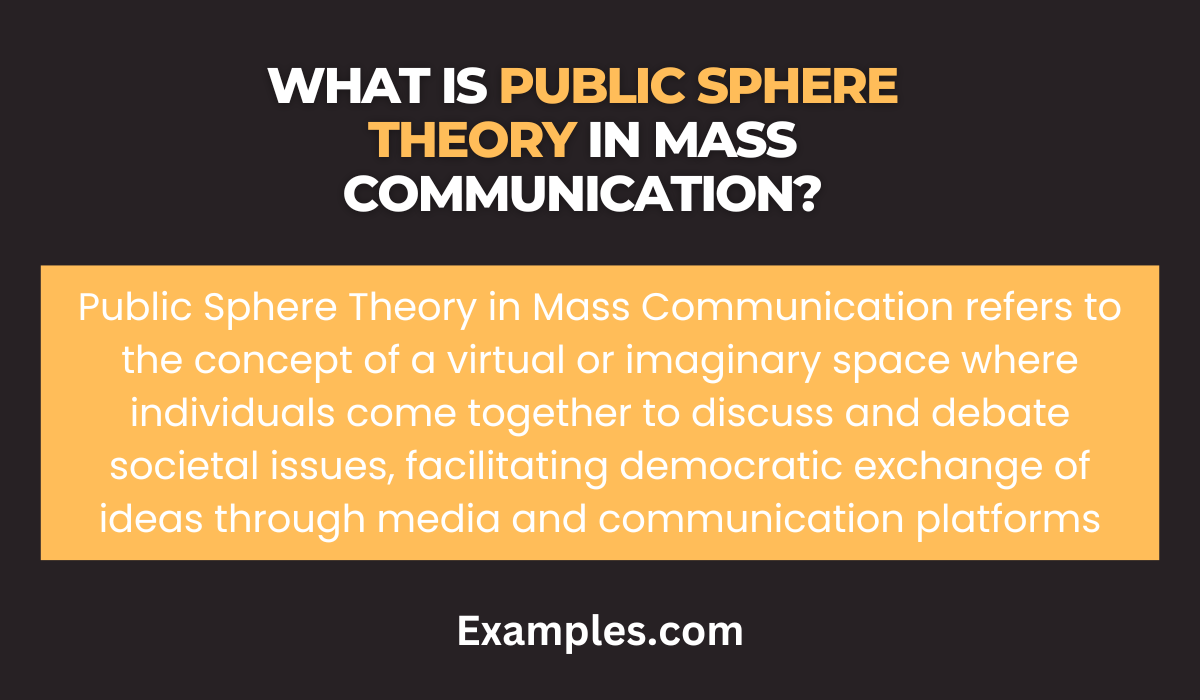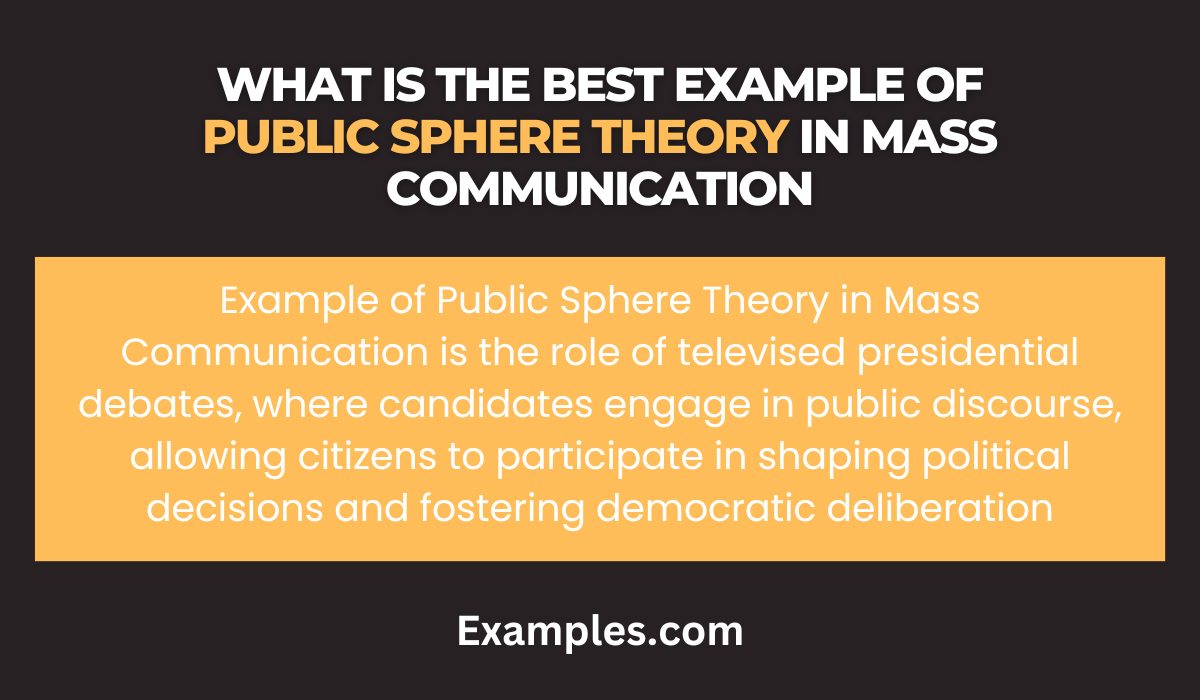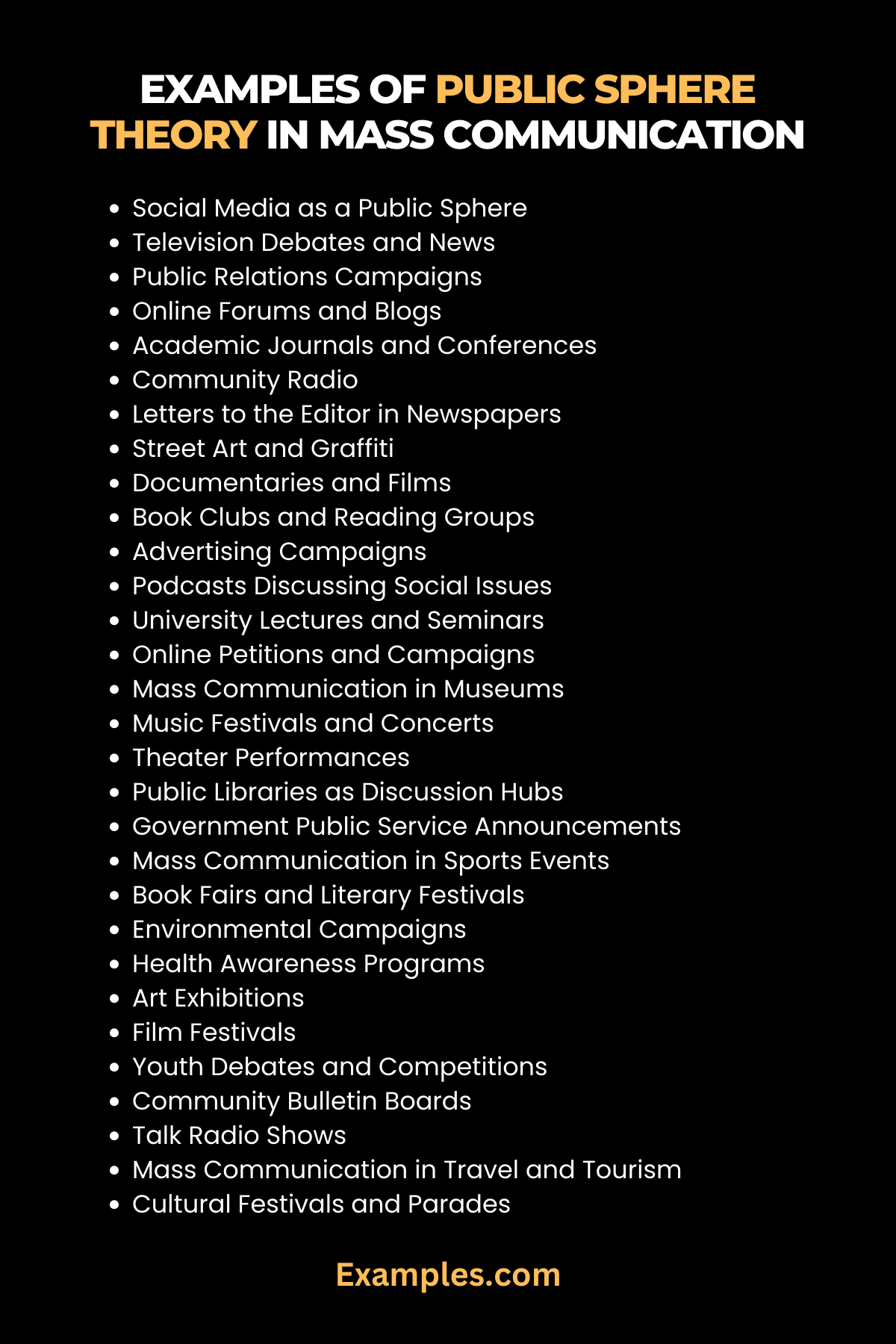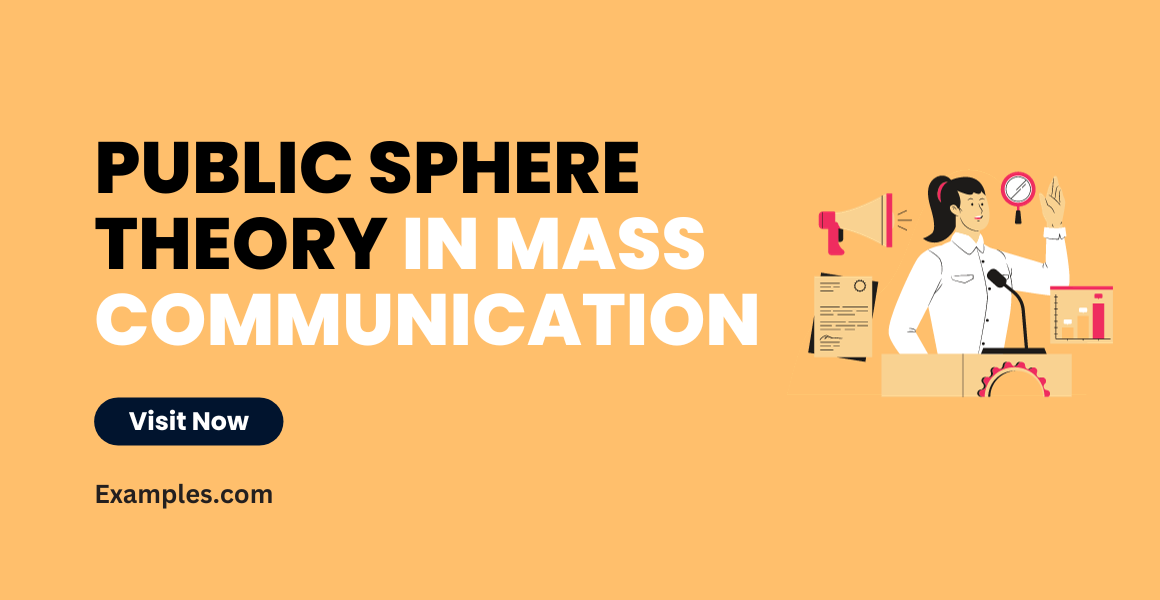29+ Public Sphere Theory in Mass Communication Examples
Public Sphere Theory in Mass Communication plays a pivotal role in understanding how society engages in discourse through various media platforms. This theory illuminates the dynamics between media, public opinion, and societal change. It offers insights into how different voices and viewpoints are represented or marginalized in the media landscape. As a cornerstone in mass communication studies, this theory aids in comprehending the complex interplay between media, culture, and power in shaping public discourse. It’s particularly relevant in the digital age, where social media and online platforms have transformed how we consume and contribute to mass communication.
What is Public Sphere Theory in Mass Communication?
Public Sphere Theory in Mass Communication is a concept that examines the role of media in facilitating democratic discussions among citizens. It posits that a vibrant public sphere, enabled by free and accessible media, is essential for the healthy functioning of democracy. This theory, originating from the works of philosopher Jürgen Habermas, suggests that mass media should serve as a platform for diverse voices and opinions, fostering informed public debates. Understanding this theory is crucial for appreciating the relationship between media, public opinion formation, and democratic governance.

History of Public Sphere Theory in Mass Communication
The concept of the public sphere is a central tenet in the field of mass communication, particularly concerning how media influences public discourse and shapes societal norms. This theory, deeply rooted in the history of communication studies, offers a framework for understanding the role of media in modern democracies.
Origins and Development
The origins of the public sphere theory can be traced back to the 18th century, with the emergence of bourgeois society in Europe. Philosopher Jürgen Habermas, a pivotal figure in this field, described the public sphere as a virtual or imaginary community which does not necessarily exist in any identifiable space. In his seminal work, Habermas argued that the public sphere emerged as a forum in which private individuals could come together to discuss matters of public interest and thereby influence political action.
During this period, the rise of print media, particularly newspapers and pamphlets, played a critical role. These mass communication examples allowed for the dissemination of information and ideas among a wider audience, a development crucial for the formation of public opinion.
Expansion and Modernization
As the 20th century progressed, the concept of the public sphere evolved with the advancements in technology and the expansion of mass media. Radio, television, and later, the internet, drastically changed the dynamics of information flow and public discourse. These new forms of media broadened the reach of the public sphere, allowing more people to participate in public debates, regardless of geographical and social constraints.
Challenges and Critiques
However, the expansion of the public sphere also brought challenges. The concentration of media ownership, issues of access and representation, and the emergence of new forms of communication like social media, have raised questions about the quality and inclusivity of the public discourse.
Critiques of the public sphere theory argue that it idealizes the role of mass media and often overlooks the inequalities and power imbalances inherent in media structures. For instance, the theory has been criticized for its focus on Western, democratic societies and its applicability in different cultural and political contexts.
Relevance in the Digital Age
In the digital age, the public sphere has undergone further transformation. The rise of digital media and social networks has created new avenues for public discourse, often labeled as mass personal communication. This phenomenon combines the wide reach of mass communication with the personalization of messages, leading to a more fragmented and diverse public sphere.
Moreover, the internet has democratized the creation and distribution of information, challenging traditional gatekeeping roles in journalism and broadcasting. However, this also raises concerns about misinformation, echo chambers, and the quality of public discourse.
What is the Best Example of Public Sphere Theory in Mass Communication
The concept of the Public Sphere Theory in Mass Communication is best exemplified through social media platforms. Social media has revolutionized the way information is shared and discussed, creating a virtual public sphere where individuals from diverse backgrounds can converge to discuss societal issues. Platforms like Twitter and Facebook serve as modern-day agoras, allowing for the free exchange of ideas and opinions. This phenomenon aligns closely with Jürgen Habermas’ concept of the public sphere, where citizens engage in rational debate and discourse, shaping public opinion and influencing political action.

30 Examples of Public Sphere Theory in Mass Communication
Public Sphere Theory is pivotal in understanding the dynamics of Mass Communication. It conceptualizes a virtual or imaginary community where individuals come together to discuss societal issues, fostering a democratic exchange of ideas. This theory is crucial in analyzing how media serves as a platform for public debate, influencing social change and public opinion.

- Social Media as a Public Sphere: Platforms like Twitter and Facebook exemplify Public Sphere Theory in the digital age. Here, users engage in discussions, share opinions, and disseminate information, impacting public opinion and policy.
- Television Debates and News: TV channels hosting debates on current affairs offer a direct manifestation of the theory. These debates allow diverse viewpoints, enabling public discourse.
- Public Relations Campaigns: PR campaigns in Mass Communication often aim to create a narrative or influence public opinion, aligning with the Public Sphere Theory by shaping the collective discussion.
- Online Forums and Blogs: Websites hosting forums or blogs serve as modern public spheres where diverse opinions are shared and debated, reflecting the theory’s relevance in digital communication.
- Academic Journals and Conferences: These platforms allow scholars to debate and discuss various theories and findings, contributing to the public sphere of academic discourse.
- Community Radio: Local radio stations often host programs discussing community issues, acting as a public sphere at the grassroots level.
- Letters to the Editor in Newspapers: This traditional form of mass communication allows readers to express their views, contributing to a larger public dialogue.
- Street Art and Graffiti: Often overlooked, street art communicates messages to a wide audience, engaging them in a public discourse.
- Documentaries and Films: These mediums often address societal issues, sparking public discussion and awareness.
- Book Clubs and Reading Groups: By discussing literature, participants engage in a public sphere, exchanging ideas and perspectives.
- Advertising Campaigns: Advertisements, especially those addressing social issues, create a dialogue among the public, embodying the Public Sphere Theory.
- Podcasts Discussing Social Issues: These digital audio platforms offer insights and discussions on diverse topics, contributing to public discourse.
- University Lectures and Seminars: Academic settings where ideas are exchanged openly mirror the public sphere concept in an educational context.
- Online Petitions and Campaigns: Platforms like Change.org allow individuals to initiate and engage in public discourse on various issues.
- Mass Communication in Museums: Exhibits and installations often provoke public discussion and understanding of cultural and social issues.
- Music Festivals and Concerts: Events that promote messages through music create a unique public sphere, merging entertainment and dialogue.
- Theater Performances: Plays and performances that address societal themes encourage audience reflection and discussion.
- Public Libraries as Discussion Hubs: Libraries often host events and discussions, fostering a community-based public sphere.
- Government Public Service Announcements: These announcements address the masses directly, engaging them in societal issues and solutions.
- Mass Communication in Sports Events: Sporting events, through their commentary and cultural significance, often spur public discussions.
- Book Fairs and Literary Festivals: These gatherings promote discourse among readers and authors, reflecting the theory’s application in literature.
- Environmental Campaigns: Initiatives addressing environmental issues often use mass communication to create awareness and public engagement.
- Health Awareness Programs: Health campaigns via various media channels contribute to public awareness and discourse.
- Art Exhibitions: Art showcases provoke thought and discussion among the public, aligning with the theory.
- Film Festivals: These festivals are platforms for filmmakers and audiences to engage in dialogues about cinema and society.
- Youth Debates and Competitions: Events specifically designed for youth engagement in societal issues reflect the theory in educational settings.
- Community Bulletin Boards: Physical or digital boards where community issues and events are posted encourage local public discourse.
- Talk Radio Shows: Radio programs where hosts and callers discuss current affairs demonstrate the theory in action.
- Mass Communication in Travel and Tourism: Promotions and narratives in this sector often spark discussions about cultural and ethical issues.
- Cultural Festivals and Parades: These events bring diverse groups together, fostering a public sphere through cultural expression and dialogue.
Role of Public Sphere Theory in Mass Communication
The Public Sphere Theory, a pivotal concept in mass communication, plays a significant role in understanding the dynamics of public discourse and media influence.
- Facilitating Democratic Discourse: It provides a framework where individuals engage in open and rational debate, crucial for democratic decision-making. This platform is where ideas are exchanged freely, fostering a well-informed public.
- Media as a Public Forum: Mass media outlets, including television mass communication and social media mass communication, serve as modern public spheres. They allow for the dissemination and discussion of information and opinions across diverse audiences.
- Influencing Public Opinion: By offering a space for public debate, the theory helps in shaping and reflecting public opinion. Media channels present various viewpoints, helping audiences form their perspectives.
- Promoting Social Integration: The public sphere acts as a melting pot of different cultures and ideologies, promoting social integration and understanding through mass communication.
- Critical Analysis of Media Content: It encourages the critical analysis of media content. Audiences are prompted to scrutinize the information presented, fostering a more media-literate society.
Importance of Public Sphere Theory in Mass Communication
Understanding the importance of Public Sphere Theory in mass communication highlights its impact on society and media practices.
- Upholding Freedom of Expression: This theory is fundamental in advocating for freedom of expression. It underscores the need for an open platform where individuals can express their views without fear.
- Empowering Citizens: It empowers citizens by providing them access to information and a platform for discourse. This empowerment is crucial in democratic societies where public opinion can influence policy decisions.
- Enhancing Media Accountability: The theory demands accountability from media practitioners. Media, acting as the public sphere, must provide accurate, unbiased information to foster informed discussions.
- Cultural Diversity and Tolerance: It promotes cultural diversity and tolerance by allowing various voices to be heard. This diversity is essential in a globalized world where understanding different perspectives is vital.
- Evolving with Digital Media: With the advent of digital media, the public sphere theory has evolved to include online platforms. This inclusion demonstrates the adaptability and ongoing relevance of the theory in modern mass communication scenarios.
How to Use Public Sphere Theory in Mass Communication
Applying Public Sphere Theory in mass communication involves several strategic approaches:
- Encouraging Diverse Participation: Media platforms should encourage participation from a broad spectrum of society to ensure a variety of perspectives are represented.
- Promoting Rational Discourse: Media should foster rational and constructive discussions, steering clear of sensationalism and misinformation.
- Integrating Digital Platforms: Embrace digital platforms like blogs and social media to expand the public sphere. This integration is crucial in the digital age of mass communication.
- Fostering Media Literacy: Educate the public on media literacy to enable critical analysis of media content, a key aspect of the public sphere theory.
- Balancing Commercial Interests: While acknowledging the commercial nature of many media platforms, it’s essential to balance these interests with the need for open, public discourse.
Public Sphere Theory in Mass Communication underscores the vital role of media in shaping democratic discourse. It highlights how various platforms facilitate public debate and collective understanding, essential for an informed and engaged society.



